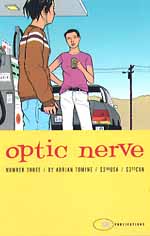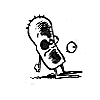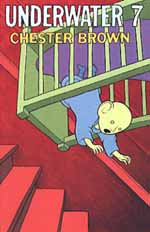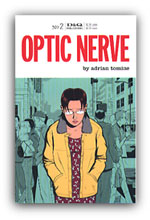Optic Nerve
by Adrian Tomine
(Drawn and Quarterly Publications)
On Nirvana's MTV Unplugged CD, just after Kurt Cobain sings the first line of David Bowie's "The Man Who Sold the World," you can hear, quite audibly, an audience member yell "Whoo!" That noise both annoys and charms me. It could represent some slacker whooping it up just to get attention, but it might also reflect genuine joy over Nirvana's Bowie cover. That "Whoo" is half-articulate, only hinting at possible meanings, elusive, indefinite.
  Click the comic for a sample panel. Click the comic for a sample panel.
These are the kinds of noises uttered and gestures made by the slacker characters in Adrian Tomine's bi-annual comic Optic Nerve. Unlike most comic creators, Tomine tells short stories without reoccurring characters, but all of these stories and characters are linked by one major theme: the inarticulateness of emotion. In Tomine's world (as in ours), a college-age jerk shows he hates his summer job at the copy shop by goofing around on deliveries, printing up a fanzine without paying for it, and spitting on reams of paper in the back room his last day on the job. A blind man expresses his attraction for a clerk at the supermarket with a few too many touches on her shoulders and arms. During a weekend trip, a teenage girl is unable to say anything meaningful to her sister or her father. All of Tomine's characters are unable to directly speak about the anger and sadness and boredom they feel, and in an era when McDonaldland jobs are everywhere, schools indoctrinate instead of teach us, and the Internet and cable TV numb us into submission, Optic Nerve is valuable because it so accurately diagnoses the failure of nerve at the center of contemporary emotional life.
The depth of insight in Optic Nerve is all the more surprising given Tomine's age. At age 16, he began Optic Nerve as a mini-comic, a stapled-together, self-xeroxed pamphlet that became such an underground success that it was eventually picked up by Drawn and Quarterly. Tomine is now 21, an undergraduate in English at the University of California at Berkeley, and clearly a sonuvabitch for having so much talent at such a young age. Look at how mature his art style is: angular, precise, discreetly decorated with zipatone (and perhaps a wee bit derivative of Dan Clowes' work), his pages are cold blueprints, diagrams of a space--a world--unpolluted by joy. I hope Tomine's own youth is full of laughter and fun, but I also hope Optic Nerve continues to dissect the sad, inarticulate yells of the slacker generation.
For more information about Tomine's comics, contact Drawn and Quarterly Publications, at P.O. Box 48056, Montreal, Quebec, H2V 4S8, Canada.
The Acme Novelty Library
by Chris Ware
(Fantagraphics Books)
Above all this comic is a triumph of design. Acme Novelty Library reflects Ware's love for the curlicue designs, bombastic slogans and ornate filigrees of turn-of-the-century newspaper ads and business signs.
 The cover to issue seven, for instance, features a reclining robot chuckling over a magazine; behind the robot, through long picture windows, we see a futuristic cityscape dotted with airships and walkways between buildings. Around the circular picture of the robot are the words "The Acme Novelty Book of Jokes," written in big cursive letters, with the word "Jokes" printed upside down beneath the laughing robot. The top of the cover is adorned with black and yellow checks, while a strip going down the right side features little drawings of some of Ware's other characters ("Rocket Sam," "Big Tex," "God") and advertising "hype" like "A dose of fancy disposing the finest humorous inventory available--a rich distribution of monkeyshines and whimsy." This cover nervously fuses nostalgia--old typefaces, obsolete diction, icongraphy cribbed straight out of 1920s science fiction--into a cascade of ironic information that seems more post- than pre-modern. And more awaits us inside the comic: newspaper layouts, cut-out toys, animation strips, big, beautifully drawn color pages. (Each issue comes in a different size, with different cut-outs and other treats.)
The cover to issue seven, for instance, features a reclining robot chuckling over a magazine; behind the robot, through long picture windows, we see a futuristic cityscape dotted with airships and walkways between buildings. Around the circular picture of the robot are the words "The Acme Novelty Book of Jokes," written in big cursive letters, with the word "Jokes" printed upside down beneath the laughing robot. The top of the cover is adorned with black and yellow checks, while a strip going down the right side features little drawings of some of Ware's other characters ("Rocket Sam," "Big Tex," "God") and advertising "hype" like "A dose of fancy disposing the finest humorous inventory available--a rich distribution of monkeyshines and whimsy." This cover nervously fuses nostalgia--old typefaces, obsolete diction, icongraphy cribbed straight out of 1920s science fiction--into a cascade of ironic information that seems more post- than pre-modern. And more awaits us inside the comic: newspaper layouts, cut-out toys, animation strips, big, beautifully drawn color pages. (Each issue comes in a different size, with different cut-outs and other treats.)
Beneath the bravura design of Acme Novelty Library, however, Ware tells sad stories. His central character is Jimmy Corrigan, whose adventure-filled childhood as "the smartest kid on earth!" has fossilized into a middle-aged bachelorhood filled with loneliness and Oedipal longing. Reading the Jimmy Corrigan stories is like reading a biography of Robin, the Boy Wonder, as written by Samuel Beckett. Ware's minor characters also inhabit worlds of longing and futility; "Big Tex," for example, wants nothing more than his father's love, while his father wishes Tex were dead. A typical "Big Tex" strip shows Dad dropping Tex off in the forest, screaming "You don't NEVER come back or try to find me or the house again because you ain't WELCUM there anymore at all, UNNERSTAND?" The final panel: a long shot of Tex standing beneath the shadows of the tree, immobile, without any place to go, friends to visit, or reasons to be. Ha, ha.
It does take slightly skewed aesthetic tastes to appreciate Acme Novelty Library. My wife works for a college's publication department, and she showed copies of Ware's comic to the professional graphic designers in her office. They adored the way the Libarary looked, but grew more and more unsettled as they read Ware's strips; I guess some spoilsports don't find violence, alienation, unrequited love and wasted lives to be knee-slapping yuks. And me? I think Ware is hands-down the most talented visual artist in comics today, and I find curious comfort in laughing into the abyss.
Order The Acme Novelty Library from Fantagraphics Books, 7563 Lake City Way NE, Seattle, Washington, 98115 (Phone: 1-800-657-1100).
Berlin
by Jason Lutes
(Black Eye Productions)
Berlin is an historical comic set in the late 1920s, and its visual style offers a nice counterpoint to that decade's "city documentaries." Films like Manhatta (Charles Sheeler and Paul Strand, 1920), Berlin, Symphony of a Great City (Walter Ruttmann, 1927) and À Propos de Nice (Jean Vigo, 1929) use quick editing, graphic matches and prowling camera movements to examine the industrial and social rhythms of the twentieth-century city.
  Click the comic for a sample panel. Click the comic for a sample panel.
Lutes instead uses long, big, vertical panels to present his view of Berlin's late-Weimar, "New Objectivity" period, and he peppers his skylines with visual references to photographs taken by August Sandler and artworks by Barthel Gilles, Frans Masereel and Otto Dix.
This is not to say, however, that Berlin is just a collection of pretty street drawings. In the two issues currently available, stories are beginning to revolve around Marthe Müller, a woman who arrives in Berlin to attend art school. But Lutes has established a deliberate, digressive storytelling pace, one that allows him to shift the narrative focus from Marthe to other Berliners, especially journalist Karl Severing and art student Richard Blunck. Berlin is slowly building a complex network of characters and locales to serve as a base for future stories --about, inevitably, the rise of the Nazi party to power. I'm confident Lutes' talent will do dramatic justice to the horrors of this historical whirlwind.
Berlin is available from Black Eye Publications, 5135 Parc Avenue, Suite 5, Montreal, Quebec, Canada H2V 4G3 (Phone: 514-274-8375).
Underwater
by Chester Brown
(Drawn and Quarterly Publications)
I've been a fan of Chester Brown's comics since the first issue of his Yummy Fur, where he serialized three excellent stories--Ed the Happy Clown, The Playboy, and I Never Liked You--that were later collected as separate graphic novels. Ed is a wild, inventive example of the taboo-busting power of the best alternative comics; the title character endures penis amputations and oceans of shit in a narrative as smart and logical as it is violent and disgusting.
 Click the comic for a sample panel. Click the comic for a sample panel. 
Brown deepened his vision with The Playboy and I Never Liked You, two harrowing autobiographical accounts of the sexual hungers and awkward infatuations of adolescence. Pre-publication buzz described Underwater as a synthesis of Ed's outrageousness and the serious storytelling of the autobiographical work, but the new comic proved to be more challenging than either.
Underwater is a comic that I both love and don't fully understand. Primarily, it's the story of Kupifam, an infant who, with her twin sister Juz, is born into a family of bald humanoids that includes her father, her mother, two big sisters, and her grandmother. I had to read four issues of Underwater to piece together this information, however, because Brown has audaciously decided to tell the story completely from Kupifam's point of view, with inexplicable dream sequences and word balloons filled with gibberish. Like Kupifam, we don't yet understand the language her family speaks: we are confronted with dialogue like "Foon is called shurewod on the sheeleejogiew. You thie foon eh lush oh look." Yet as the series goes on (issue seven is the most recent), more English words begin to appear in the dialogue ("Your kufur will be right back with a toksh"), and Kupifam herself begins to speak, reflecting her increased comprehension.
Yet in many important ways, Underwater is more about pictures than words. Brown remains a consummate graphic storyteller, and there are several sequences in the book--Kupifam crying silently in her crib in issue two, Kupifam's dream about an orifice in the wall at the end of issue four--that have a surreal power than transcends language. Also, Kupifam has grown and learned language faster than her sister; she often bites Juz, steals her toys, and demands an undue amount of attention from their parents, in wordless panels that eloquently and dispassionately explore the links between immaturity and cruel behavior. I have no idea where Brown is going with this cruelty theme, or with anything else in Underwater, and in a medium dominated by predictable superheroics, this is a blessing.
One warning, however. In Heaven, Chester Brown will work on a graphic novel from beginning to end, and the novel will then be published in its entirely. Due to the imperfect economics of the earthly comic book business, however, Brown is forced to regularly publish his work in short chapters. But these chapters do not stand independently from all the other issues in the series; reading Underwater is not the same as picking up a random issue of Superman (thank God). Begin from the beginning, and slowly work your way through each issue in order. I have a feeling future issues will more than justify our patience.
Contact Drawn and Quarterly Publications (address above) for more information on taking your first plunge Underwater.

Most of you probably care more about icy build-up in your refrigerators than you do about comics distribution, and I don't blame you. Surely the crummy superhero comics that line most comic shops chase away any remotely adult consumer, and you're wise to stay away. And although I desperately hope I've pissed off any geek who actually reads superhero crap, my ranting won't have any effect on folks willing to spend good money on toilet paper like Marvel and Image comics. So who's left? People who try to read the good, mature comics? They know the situation--they know that an entire art form is being decimated by greedy, monopolistic business practices, and they pray for the days when good comics like the ones reviewed above are readily available at both comic and mainstream bookstores. This prayer will likely be answered at about the same time Switzerland annexes the United States.
My local comic shop is a sweaty fan-boy joint that stocks about 200 copies of Batman and two copies of Acme Novelty Library. Two days after I read a favorable review of Scott McCloud's Understanding Comics in the Chicago Tribune, I asked if the store could order McCloud's book for me. The manager's reply: "Nah. Too much trouble. Nobody will want to read that book." And nobody will be ABLE to read Understanding Comics, or Underwater, or Optic Nerve, or Frank, or Peepshow, or Berlin, or Fleener, or Naughty Bits, or Palookaville, if retailers like this jackass, coupled with Marvel's distribution strategies, get their way. Maybe this article is just a covert obituary for the death of comics art; perhaps we could prolong its suffering if we go to our local comic store and request, badger, and implore that they order good stuff. Or maybe we should instead order adult comics directly from the publisher. I don't know. I don't have any easy answers.
Craig Fischer is one of the
editors of Cinema Journal. He also teaches English at the University of
Illinois.
page 2 of 2

|

 I continue to hope, against hope, that if enough comic artists do mature books, and if enough fans buy and praise them, a more mainstream audience will materialize. Comics distribution is still unstable--Marvel now distributes through Heroes World and the R.R. Donnelly company, and Diamond recently bought out Capital--so we clearly (and desperately) need to crawl out of the comic shop ghetto.
I continue to hope, against hope, that if enough comic artists do mature books, and if enough fans buy and praise them, a more mainstream audience will materialize. Comics distribution is still unstable--Marvel now distributes through Heroes World and the R.R. Donnelly company, and Diamond recently bought out Capital--so we clearly (and desperately) need to crawl out of the comic shop ghetto.


 Click the comic for a sample panel.
Click the comic for a sample panel.
 The cover to issue seven, for instance, features a reclining robot chuckling over a magazine; behind the robot, through long picture windows, we see a futuristic cityscape dotted with airships and walkways between buildings. Around the circular picture of the robot are the words "The Acme Novelty Book of Jokes," written in big cursive letters, with the word "Jokes" printed upside down beneath the laughing robot. The top of the cover is adorned with black and yellow checks, while a strip going down the right side features little drawings of some of Ware's other characters ("Rocket Sam," "Big Tex," "God") and advertising "hype" like "A dose of fancy disposing the finest humorous inventory available--a rich distribution of monkeyshines and whimsy." This cover nervously fuses nostalgia--old typefaces, obsolete diction, icongraphy cribbed straight out of 1920s science fiction--into a cascade of ironic information that seems more post- than pre-modern. And more awaits us inside the comic: newspaper layouts, cut-out toys, animation strips, big, beautifully drawn color pages. (Each issue comes in a different size, with different cut-outs and other treats.)
The cover to issue seven, for instance, features a reclining robot chuckling over a magazine; behind the robot, through long picture windows, we see a futuristic cityscape dotted with airships and walkways between buildings. Around the circular picture of the robot are the words "The Acme Novelty Book of Jokes," written in big cursive letters, with the word "Jokes" printed upside down beneath the laughing robot. The top of the cover is adorned with black and yellow checks, while a strip going down the right side features little drawings of some of Ware's other characters ("Rocket Sam," "Big Tex," "God") and advertising "hype" like "A dose of fancy disposing the finest humorous inventory available--a rich distribution of monkeyshines and whimsy." This cover nervously fuses nostalgia--old typefaces, obsolete diction, icongraphy cribbed straight out of 1920s science fiction--into a cascade of ironic information that seems more post- than pre-modern. And more awaits us inside the comic: newspaper layouts, cut-out toys, animation strips, big, beautifully drawn color pages. (Each issue comes in a different size, with different cut-outs and other treats.)



